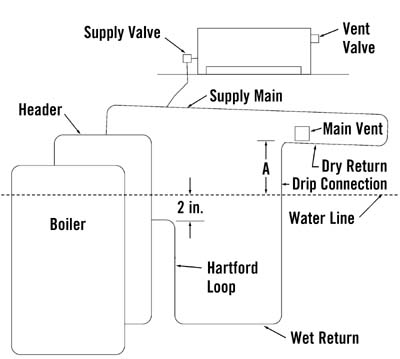THE BOILER
Fueled by various sources such as gas, wood, oil, or coal, the boiler fires automatically, boils water, and produces steam. System controls maintain pressure and also protect the boiler.PIPING ARRANGEMENTS
There are two different types of piping arrangements commonly found today in steam heating systems — one-pipe and two-pipe systems.A one-pipe system uses a single pipe to both supply steam to radiators and return condensate to the boiler. (See Figure 1.)
Two-pipe systems incorporate one pipe to supply steam to radiators and a separate pipe to return condensate to the boiler. (See Figure 2.)
Piping within the boiler piping arrangement is designated by name and serves specific functions. The following are a few common components:
Header — The horizontal pipe located above the boiler that connects vertical pipe(s) from the boiler to the main supply line.
Steam supply main — Connects to the header and delivers steam via branch run-outs to the radiators. It will also deliver condensate to the drip connection in a one-pipe system.
Drip connection — The pipe that connects the steam main to the return. Located at the end of the main, this vertical pipe drips condensate into the return piping.
Dry return — The section of return piping located above the water line in the boiler.
Wet return — The section of return piping located below the water line in the boiler. This piping should always be full of water in the form of condensate returning to the boiler.
Hartford loop — A piping arrangement designed to prevent water from pouring out of the boiler should there be a leak in the return piping.
Equalizer and header drip connection — Piping that exits the header and connects back into the return inlet to the boiler. Its purpose is to keep an equal amount of pressure on the return, preventing boiler pressure from forcing water back up the return line.


STEAM VENTS
For a steam system to work properly, air must be eliminated from the piping and radiators. This process is accomplished with vent valves.Radiator vents are located on the opposite side of where steam enters a radiator in a one-pipe system.
Main steam vents are located on the end of the main supply line in one- and two-pipe systems; they are located in vertical risers in two-pipe systems.
TRAPS
The trap’s job is to separate steam from condensate. The following are two of the more common types of traps found today:Thermostatic radiator trap — Located on the bottom of the radiator in a two-pipe system, this trap, actuated by sensing steam pressure, keeps steam in the radiator while regulating the discharge of air and condensate.
Float and thermostatic trap — Typically located at the end of a supply main in a two-pipe gravity return system, this trap prevents steam from reaching the dry return piping. The thermostat in the trap will allow the discharge of air until it senses steam. Condensate is discharged and regulated by way of the float. The two functions act independently of each other.
CONTROLS
Low-water cutoff— A safety control that monitors the water level in a boiler via an electronic probe or float. If the water drops below a predetermined safe operating level, the control turns off the burner and prevents the boiler from overheating.Automatic water feeder — This safety automatically adds water to the boiler should the water drop below a safe operating level.
Pressuretrol — This control regulates system operating pressure. The control is set to fire the boiler when it reaches a minimum pressure setpoint, referred to as the cut-in setting. When boiler pressure reaches its maximum set point, the burners disengage. This is referred to as the cutout setting.
For additional information on steam heating, visit www.heatinghelp.com (website).
Rothacker is a director of area51hvac.com. For questions or comments on the Tech Page, contact Rothacker at ewizaard@hotmail.com (e-mail).
Publication date: 12/23/2002

Report Abusive Comment